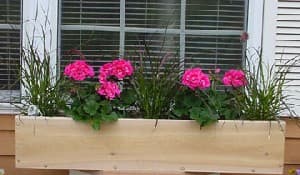Container Gardens for Space Constrained Gardeners

Get Creative with Container Gardens
Do you want to grow some flowers or vegetables, but you have no space? Get creative! Container gardens allow just about anyone to grow a garden.
Everybody can grow flowers and vegetables. Yes, we mean everybody. No matter where you live, no matter how small your space. Container gardening is the answer for people with little space for their favorite plants. You can grow countless plants in a container or planter. Small and compact, you can put a planter on your balcony or deck, or in a sunny window. Think two-dimensional. A planter or vase does not have to sit on the patio or deck. Many people hang containers from a ceiling or on a wall. For example, a windowsill planter is a great way to create space for your favorite flowers. This is called “vertical gardening“.
Imagination is the key to successful container gardens. First, determine what kind of plants you want to grow. Second, browse the type of planters or containers available to you. The internet makes this task easy. Then, imagine the bountiful harvest of flowers and/or vegetables that you will enjoy because it is certainly within your reach.
Selecting the Right Plants for Container Gardens
The right plants are the ones you select to grow. They can be flowers, vegetables, herbs, or even small bushes. While most people traditionally think of small plants, if you want to grow a particular plant, give it a try. Very few plants are not adaptable to container gardens. Corn, for example, may make an unsuitable vegetable, as it takes numerous plants to properly pollinate the ears. But most others are just fine. You might think sunflowers grow too tall to thrive in a garden planter. However, there are short varieties that grow just two to three feet tall.
Even vining plants can find a comfortable home in a planter. Some people grow pumpkins and squash in containers from their decks. The vines are allowed to hang down the deck or sprawl across the floor. One woman I know just had to grow pumpkins. She planted them in an old kiddie pool…on top of her apartment complex in downtown Los Angeles!
Types of Containers or Planters
There is virtually no limit to the type of container you can use. And, here is where the fun and your creativity begin. Look for a container suitable to your tastes and decor. Try using buckets, barrels, watering cans, and vats, to name just a few. If it holds soil, it can probably be your container!
Size is also important. If you are selecting larger plants, then a large container is required. Many plants do not like to be root-bound, so make sure to provide ample size. The depth and width of the container are equally important as roots spread out and down from the stem.
How to Grow Plants in Container Gardens
Container plants dry out easily. Make sure to check them. They may require water daily in hot and dry weather. The smaller the container, the more often you need to water your plants. If you are going away, have a neighbor check them.
Avoid overcrowding your plants. The limited space means limited water and nutrients.
Containers need to have proper drainage. The container you use needs to have holes in the bottom for drainage. The plant’s roots can rot in overly wet or waterlogged soil. Usually, three or four holes in the bottom of the container will suffice.
Add fertilizer regularly. Frequent watering will wash out important nutrients. Try slow-release fertilizers.
Rotate your containers in a circular motion every couple of days to provide even sunlight to all the plants in the container.
If your plant becomes too big for its container, consider repotting. This may not be practical for seasonal plants and annuals. However, it may be a necessity, for container-grown shrubs and perennials. More on repotting plants.
More Resources
Please support our site. Shop for:
- rmmatthews100@hotmail.com
- 585-721-6528
- Rochester, NY
©1999-2024 GardenersNet.Com, All Rights Reserved

